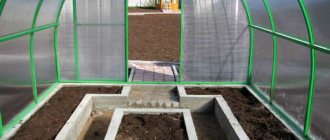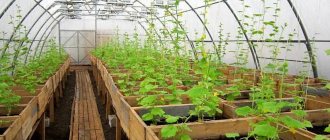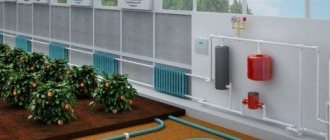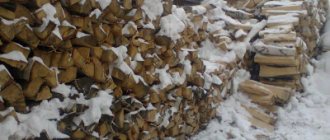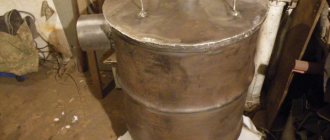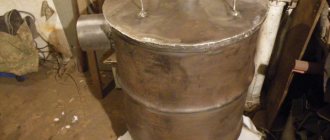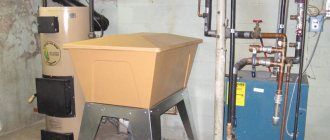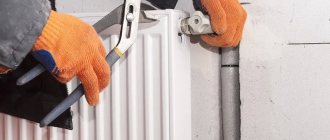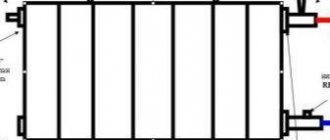This article presents photos and videos of the company GRV (Gruzdev boilers)
Greenhouses are actively used for growing cucumbers, tomatoes, lettuce and other crops year-round. In the greenhouse, with the help of heating equipment, boilers and heat generators, air and soil are heated to the required levels. Temperature directly affects the development of vegetable crops as well as watering, sunlight and nutrients. In addition, the risk of pests is reduced, which affects the quality of the crop in the end, and the presence of diseases with proper disinfection of the soil after building a greenhouse, the risk of diseases is greatly reduced.
There are special requirements for temperature conditions in nurseries; for them we recommend combined boilers that heat air and water. Hot water is used to heat the soil and the irrigation system, and hot air is used to heat and ventilate the greenhouse.
Rice. 1 Photos of GRV heat generators for shipment for heating greenhouses
The GRV solid fuel heat generator was originally designed for heating greenhouses, but has found a very wide range of applications. Over the past two heating seasons, we have improved aerodynamics and increased the efficiency of the unit. Due to its high properties, the heat generator is also used for drying, and some greenhouse farms use it all year round. In summer for drying chambers, in winter for heating.
Heating can be: with manual fuel loading and automatic
Rice. 2 For heating in manual mode, a slab is suitable. GRV heat generators are adapted for this
For heating: air heating, combined heating (we heat air and soil), water heating registers.
In order to heat a greenhouse with an area of 500 sq.m. you will need:
1. Concrete platform for placing the heat generator under its base
2. A set of air ducts according to diagram No. 1 or diagram No. 2 (see below)
3. Perforated mounting tape for mounting air ducts or fastening according to the drawing (see below)
4. If there is no 380V voltage on the site, then you should purchase a frequency converter (you can order from our company) it will convert from 220V to 380V.
5. Next, the installation of air ducts and chimney installation is carried out
This system is guaranteed to work only with GRV heat generators, which already operate more than 40 greenhouses throughout Russia. TG and “pyrolysis” heat generators are not intended for heating greenhouses.
Particular attention is paid to the design of the heat generator, which should ensure operation with the same efficiency as a hot water boiler
Rice. 3 Decoupling unit. The so-called “pants” are needed to distribute air on the left and right sides
Rice. 4 Different colors indicate different elements of the duct system
Please note in diagram No. 1 that the fuel loading neck and the firebox door are located outside the greenhouse. Firstly, this allows you not to enter the greenhouse at night, i.e. Close it with a lock, do not let it get too hot. The firebox and ignition are carried out outside the greenhouse. You can make a light shed or make a boiler room from lightweight structures. It is important to occupy the minimum usable area of the greenhouse. Every square meter of a greenhouse should be profitable.
Rice. 5 Installation of air ducts in a wooden greenhouse
To secure the air ducts, you should use perforated mounting tape, which can withstand high tensile loads and is easily mounted to the greenhouse frame
Rice. 6 Mounting tape for air ducts
When choosing a layout of air ducts, you should contact a specialist at GRV; depending on the design of the greenhouse and the type of plants, the air ducts should be placed differently and the selection of fans should also be chosen correctly
Rice. 7 Installation diagram of the GRV heat generator, which runs on coal and wood. Fuel can be loaded from the street, this reduces the number of unnecessary visits to the greenhouse
Rice. 8 Photo taken during operation of a 400 kW heat generator. Most of the smoke is steam, since usually freshly cut firewood and slabs with high humidity
The heat generator can be supplemented with automatic fuel supply, a vortex burner using pellets, husks or sawdust.
Rice. 9 Heat generators are long, which allows the use of any slab or wood waste for heating the greenhouse
Rice. 10 For stability, the heat generator is turned over on its side
Rice. 11 Vortex burners on pellets for heat generators and boilers. Installed inside the greenhouse
Using the example of objects with greenhouses, an automatic fuel supply system reduces labor costs by 2-4 times. One person is able to control the heating of 5 operating units at once, this is more than 10,000 sq.m. greenhouses
Rice. 12 For particularly large heat generators, the chimney is installed inside the mast
A very detailed video on the installation and design of the heat generator is presented below. This object is located in the Krasnodar region. A wood-fired heat generator with a power of 400 kW heats a greenhouse area of 2000 sq.m. All types of crops are grown in the greenhouse. Type of fuel: firewood, slab. An extension has been organized for the heat generator, which is combined with the greenhouse. But a roof made of non-combustible material is installed above the heat generator. We have selected the most minimal radial fans to reduce energy costs. In a greenhouse, which is very important, the humidity process is optimized; plants are less susceptible to diseases than with high humidity. Since the GRV heat generator gives a large temperature delta, it is easy to ventilate the greenhouse in any weather outside, additional air intake from the street is possible, and not cold but heated air enters the greenhouse
Fully automatic greenhouse heating with air heat generator GRV
Air heating using GRV heat generators allows you to effectively maintain the microclimate in the greenhouse in accordance with all requirements for temperature and humidity in the greenhouse. GRV heat generators for greenhouses are designed with a power reserve and maximum efficiency for these devices. Automatic piston fuel supply has greater force than auger fuel supply, does not fail when foreign objects enter, and is easy to maintain.
To control the temperature, the heat generator comes complete with a control panel based on the domestic programmable controller PR200 with wide functionality and the possibility of additional expansions at the request of the customer.
Rice. 13 Scheme of a greenhouse and air heating with fully automatic operation
Video of the operation of an automatic heat generator for air heating
Rice. 14 Top view plus specification of elements for heating a greenhouse of 500 sq.m.
Rice. 15 This is the diagram for installing a heat generator for heating a greenhouse. Its location should be close to the exit from the greenhouse. Due to the large bunker, loading is carried out once a day or once every two days, depending on the outside temperature
As mentioned above, air heating is fast, efficient and inexpensive. But there are objects in which installing air heating is problematic, for example, many free-standing greenhouses, or a greenhouse with an area of 10 thousand square meters. In this case, we install water heating boilers with automatic or manual fuel supply.
Rice. 16 Universal hot water boiler for heating an industrial greenhouse. The boiler is installed directly
Heating of a greenhouse with an area of 1000 sq.m. usually carried out by a boiler of 200 kW per hour.
- Heating can be either air or water using a network of registers and an assembly manifold.
- If there are several greenhouses, preference should be given to the automatic GRV series (they come with a universal firebox)
- The hot water boiler is installed in a greenhouse or boiler room. To install the boiler in a greenhouse, you should use a special “vestibule”; if you heat it manually with wood or coal, opening the doors is inevitable
- Mandatory reserve for the power of the boiler and the heating system itself
- The boiler must be more powerful than the heating system for firing at night in the winter when there is no heat source in the form of the sun
Rice. 16 Heating a greenhouse 1000 sq.m. hot water boiler
It is important that when choosing a boiler, the size of the firebox is taken into account. In winter, there is a lot of worries in the greenhouse, and it is not always possible to burn with chopped wood.
Rice. 17 Piping unit for two heating of two greenhouses with an area of 2000 sq.m. at an existing facility
Rice. 18 Scheme of hot water heating of a greenhouse using air heaters. This greenhouse has an area of 600 sq.m. To cut off the cold, registers are laid on the sides of the greenhouse in two branches of 76 mm pipe. The heaters are powered from registers, thus saving material and reducing the cost of the main pump. The uniformity of the flow is ensured by installing a small capacity pump on each heater
Rice. 19 On the previous slide, a scheme for hot water heating of a greenhouse can be developed; a universal boiler GRV 150 is installed in the boiler room of the greenhouse, which runs on pellets and wood. A firebox with a length of more than 1500 mm provides the ability to dispose of solid waste
How to choose the best boiler?
When choosing a boiler with which you plan to heat the greenhouse, it is necessary to take into account the footage and cubic capacity of the room, as well as material costs associated with purchase, installation, etc. Preferable is equipment that uses long-burning technology - in this case, two boilers are produced per day. fuel bookmarks.
However, the cost of such boilers is high. The larger the area of the heated room, the sooner the payback period will occur. In small greenhouses (about 20 sq. m.), the payback period for technical equipment can last up to 10 years. In these circumstances, it is recommended to install solid fuel or gas devices, which, for greater efficiency, are equipped with a system for pumping water through pipes, which will allow the room to be evenly heated.
An electric boiler is not economical, consuming a large amount of electricity. When using it, the upper part of the greenhouse room warms up, but the lower part does not receive full heating, which causes the plants to freeze. Combined long-burning models are industrial and operate on gas or liquid fuel.
Did you know? The cauldron is depicted on the coat of arms of the city of Kronstadt. This is due to the fact that the mentioned city is located on the island of Kotlin.
The cost of such equipment is high and economically justified for large greenhouses when growing plants that are extremely demanding on temperature changes (strawberries, raspberries, eggplants). A long-burning pyrolysis solid fuel boiler has high heat transfer, is economical and at the same time highly productive.
However, it is large in size: due to the high heat transfer, plants must be planted at a distance of more than half a meter from the boiler. Therefore, it cannot be installed in small greenhouses. In case of unforeseen circumstances, a stationary wood stove or a mobile pellet boiler will come to the rescue, which, if necessary, is heated with any solid fuel (wood, corn cobs, etc.).
Disadvantages of pellet heating
- High cost of equipment. A domestic boiler with a capacity of 20 kW will cost 170 - 200 thousand rubles; imported, from a manufacturer with a good reputation in the Russian market, will cost 200-250 thousand or more. It is important to understand that the chimney and its installation are not included in this amount.
- Large dimensions and weight. A 20 kW pellet boiler weighs from 200 to 400 or more kilograms, and is equipped with a hopper with a capacity of 150 - 300 liters. It is clear that the installation of such equipment can only be floor-mounted.
- Large combustion area for a pellet boiler. On average, one boiler requires at least 9 m2 of area, since according to safety requirements, the gap between the boiler and the wall (or other structures) must be at least 1 m on each side, and for a device with side service it is advisable to increase it to 1.5 m.
Pellet boiler in the boiler room
- The pellet boiler is absolutely dependent on electricity and cannot be used during a power outage.
- Loading pellets requires labor. The bunker is loaded manually; You can quite imagine how many kilograms of fuel you will have to carry on yourself if the capacity of the bunker is hundreds of liters.
- The boiler requires regular cleaning; with constant use, this should be done 2 times a month. Neglecting this rule can lead to damage to the fuel supply screw, and carbon deposits reduce the efficiency of the boiler.
- A separate large room is required to store pellets. If the house is used for permanent residence, then one heating season may require up to 10 tons of pellets - this is approximately 20 m3. You cannot store pellets in the open air or under a canopy: they are very hygroscopic (it’s not without reason that they are used to make inexpensive litter for cat litter boxes), and burning raw pellets leads to the accumulation of creosote in the boiler. Therefore, the main requirement for a room for storing them is good waterproofing, a more or less constant temperature and distance from sources of fire and strong heat.
Loading pellets into the boiler
Greenhouse heating methods
To maintain the temperature regime, the following types of heating are applicable:
- steam, water;
- air;
- gas;
- electric;
- stove
Air
Air heating is carried out in two ways:
- heated air is taken from the external environment and heated in the supply ventilation system;
- Using gas convectors or fan ovens, the internal volume of air is heated.
Water
Water heating is the most popular type of heating in winter. Possessing unique physical and chemical properties, water is a coolant for most heating systems. Units to which cool-water systems are connected can operate on any type of fuel. In this case, it is possible to equip the stoves with a water circuit, and, therefore, the system functions according to all the principles of water heating.
Butakova
Today, the market offers a wide range of stoves from various manufacturers. The rectangular unit is equipped with an ash pan. It has convection pipes. The operation is similar to the previous heating equipment. Thanks to its special design, Butakova is highly efficient. Despite all its advantages, it is rarely used for heating greenhouses.
When installing and constructing equipment, it is worth taking into account the design features and operating principle
Types of boilers
Below is a more detailed description of the various devices.
Important! If a cyclic heating mode is used, then it is recommended to use a non-freezing liquid or antifreeze as a coolant liquid.
Gas
It operates using liquefied or natural gas, and water of any quality is used. The boiler is installed in a greenhouse in a free space. The device includes a heat exchanger, an atmospheric burner, a pump, an expander (tank), and a safety valve. A working boiler heats water in a heat exchanger and uses a pump to supply it to the system circuit. The smoke is diverted and removed through a chimney or pipe.
Register - heating equipment consisting of smooth-walled pipes connected to each other by welding. Typically, the tubes are arranged horizontally and secured to each other by vertical jumpers, through which the coolant also moves. Registers are often installed in heating systems intended for technical and industrial premises.
Algorithm for connecting the register to the main unit:
- Understand where the hot and cold water inlet and outlet are located in the water circuit.
- In the end parts of the register, holes are drilled for threaded couplings, which are the basis for fittings connecting the heat exchanger to the water circuit.
- Using a welding machine, the air vent is secured (from the supply - on the opposite side). The optimal location for attaching the valve is the top.
- Considering the large mass of the register, a reliable fastening system should be provided. When placed on the floor, these are stable legs and additional fixation to the wall.
- A distance of at least 25 cm is maintained between the register and the surrounding walls or objects.
Did you know? The first armored car in history was designed in 1916
—
the basis of its body was a boiler brought from the Guinness brewery.
- Advantages of heating a greenhouse using a gas boiler:
- ease of maintenance;
- very fast heating and uniform distribution of warm air inside the greenhouse.
- Flaws:
- Since the installation of the above-described equipment is advisable in large-volume greenhouses, the price of the system will be high.
- Approval is required for connecting equipment and gas supply, which also involves significant material costs.
Solid fuel or pyrolysis
Pyrolysis is a chemical process that occurs at high temperatures and low oxygen content in the combustion chamber, which releases excess thermal energy. In solid fuel pyrolysis boilers, wood (or other solid fuel) is burned with the release of pyrolysis gas and the formation of coal residues. In boilers of this type, the generated gas is subsequently burned. During the combustion process, carbon is oxidized not to CO², but to CO (carbon monoxide).
List of fuel types for pyrolysis boilers:
- firewood
- briquettes;
- sawdust, chopped branches;
- pellets;
- coke;
- coal;
- peat.
Wood is most preferable, since the process proceeds with the maximum release of pyrolysis gas.
You can use a combination of firewood with sawdust, branches and pellets. It is not worth burning with sawdust or finely chopped branches, as the boiler will not work or the efficiency will be extremely low. Important! In rooms with large heat losses (solid glazing, drafts, high ceilings), it is necessary to install a boiler with increased power. If the generation of hot water supply equipment is implied , the calculated
power increases by another 20
-
50%.
The sequence of operating processes for a solid fuel (wood) pyrolysis boiler:
- Firewood is loaded onto the grate.
- After igniting the fuel, close the door tightly and open the smoke exhauster.
- Air begins to flow into the upper chamber due to the pressure difference.
- The resulting pyrolysis gas falls into the lower furnace, in which it burns.
- After a period of time, the air circulation stabilizes, combustion in the fireboxes proceeds evenly. It is necessary to monitor the stability of the processes occurring in the upper and lower furnaces, and promptly remove ash from the lower chamber.
- During the combustion of the top layer of fuel, the funnel-shaped distributor is lowered, thereby supplying air for permanent combustion.
- Gases formed during the combustion process are discharged through the chimney.
- Advantages:
- Efficiency reaches 90%;
- long interval between fuel loadings (up to several days);
- combustion is constant, therefore, the temperature of the coolant is stable;
- comfort in equipment maintenance.
- Flaws:
- considerable dimensions. The height of a pyrolysis oven is higher than that of a conventional wood-burning oven;
- the loaded fuel must be completely dry;
- During the combustion process, carbon monoxide is released - it is necessary to carefully monitor the CO level sensors;
- high price.
Electrical
Electric boilers in small greenhouses are connected to a 220 V network. For greenhouses with large areas - from 100 sq. m and above, the project provides for three-phase high-power units that are powered from a 380 V network. Equipment (pipes, radiators, etc.) is usually connected to the electric boiler so that additional water and electric heating of the entire volume of the greenhouse is possible.
- The undoubted advantages of this type of system include the following:
- ease of installation, operation and maintenance;
- environmental friendliness (no waste from the combustion process, as well as noise during operation);
- small sizes;
- reliability.
- The disadvantages include the following factors:
- high cost of energy;
- constant electrical power is required.
Diesel
Diesel boilers are rarely used to maintain the temperature inside the greenhouse. This is due to the fact that in addition to the large dimensions of the unit itself, it is necessary to provide an additional location for the fuel tank. In addition, additional equipment with convectors and (or) pipelines will be required.
Important! If you plan to connect a gas boiler to a homemade heating system, the participation of a gas technician is required. In this case, independent work is prohibited!
- The undoubted advantages are:
- high efficiency;
- automatic fuel supply;
- relatively low price of the boiler.
- Flaws:
- high cost of fuel;
- large dimensions;
- noise during operation, the unit emits a persistent specific odor;
- the need to install a chimney;
- fire hazard.
Waste oil devices
Installing a heat generator that works using any available waste oil (machine, pyrolysis, animal and vegetable oils, crude oil, kerosene, etc.) allows you to heat the room using hot air. A stove of this operating principle is also installed as an additional heat source for an existing one. When used independently, this type of device requires the installation of a chimney and a fuel tank, which is not a costly undertaking.
- Pros:
- low cost of fuel raw materials. “Exhaust” devices are especially beneficial for those who have constant access to a fuel resource (pizzerias, fast food restaurants, service stations);
- rapid heating of the room due to high heat transfer;
- low cost of the repair kit.
- Minuses:
- increased oxygen consumption.
Combined
Boilers of this type allow the use of various types of fuel in any combination (depending on the model and manufacturer). Initially, it is necessary to decide which type of fuel will be a priority and which will be a secondary one. This type of equipment is often formed according to the principle of a designer.
Just like a single-fuel boiler, the main elements of a combined boiler are a heat exchanger, a reliably insulated casing (minimizing heat loss), and an automatic control system. For household needs, when operating in small spaces, the choice is a double-circuit boiler with the ability to operate on two types of fuel.
- Positive points:
- uninterrupted operation;
- selection of the preferred fuel at the time of operation of the unit;
- ease of use.
- Flaws:
- high price;
- complex setup;
- expensive repairs;
- the need to store several types of fuel raw materials.
Why are pellets considered an economical fuel?
Pellets are elongated granules with a diameter of 6-8 mm, made from wood waste. In production, wood raw materials are cleaned, crushed, dried and pressed under pressure of 300 atmospheres. It is noteworthy that no chemical additives are used to form granules: the binder is natural lignin contained in wood.
Indeed, the price for them is higher than for firewood: a ton of good quality pellets costs from 7 to 13 thousand rubles. However, in the process of processing wood raw materials, the amount of pure carbon in it increases, as a result, the calorific value of pellets is approximately 1.5 times higher than that of firewood. In the popular science program “Galileo,” they even conducted an experiment by burning equal amounts of wood and pellets in a calorimeter, and the superiority of the latter was confirmed. That is, in simple terms, to obtain a certain amount of heat, pellets will require significantly less than firewood. In addition, pellets are more environmentally friendly: during their combustion, less CO2 is released and less waste (ash) is generated. It is significant that in Europe, which is seriously concerned about environmental and economic issues, pellets are considered a very promising type of biofuel, their production volumes are growing, and in some EU countries the share of households using pellet boilers for heating is approaching 2/3 of the total. It is important that pellets, unlike firewood, have the same small size and can be supplied in uniform portions using mechanical devices, which allows pellet stoves to have a much higher degree of automation than wood-burning devices.
Pellets
Making a greenhouse boiler with your own hands
The first step towards self-installation of heating equipment in order to create a heated greenhouse in a personal household should be a detailed drawing of the planned heating installation. The required power is also calculated based on the area and volume of the room, type of boiler, type of fuel, operating time, etc. After a painstaking process of theoretical pre-preparation, one should proceed to the main stages of creating a boiler.
You will be interested to know how to insulate a greenhouse for the winter with your own hands.
Materials and tools
For a simple solid fuel boiler model you will need:
- A metal barrel with holes or an old gas cylinder, sawn in half.
- Water circuit or coil.
- Hinges, metal handles, matching latches, etc.
- Welding machine.
- Cutting tools.
Construction and connection
The most common model of a homemade boiler looks like this:
- The cylinder (barrel) is placed in a metal oven.
- A chimney pipe is welded to the resulting structure, through which gases will be discharged from the greenhouse premises to the outside.
- The last stage is welding pipes (plastic, metal) together and their further installation.
Video: how to make a solid fuel boiler with your own hands
Requirements and heating scheme
When installing solid fuel boilers for greenhouses, you should pay attention to the following parameters:
- construction area;
- calculate the system power;
- presence of insulation;
- the ability to control the operation of the system;
- material opportunities.
If you take all these factors into account, you can choose a truly effective system that will allow you to heat the greenhouse without much expense. It is worth carefully considering all available options.
Average score of ratings is more than 0
Share link
Comments There are no comments yet, but you could be the first...
Possible problems with a homemade device
- The most common problems when operating a homemade heating unit are:
- uneven heating of the internal space;
- excessive dry air.
Both factors negatively affect the condition of the plants in the greenhouse, so you should be especially careful when laying air pipes and providing additional air humidification. Undoubtedly, the selection and installation of technically complex, expensive equipment requires a considerable amount of time and effort to study the issue. However, these efforts can be attributed to a prolonged investment in a future rich harvest, which will delight you both morally and materially for more than one season.
Fuel briquettes ↑
Briquettes are waste of various types, compressed into blocks. By the way, they are also called eco-firewood. Eco - because the emission of carbon dioxide from them is negligible. Peat waste, wood residues (sawdust, wood chips, shavings), as well as agricultural waste (straw, corn stalks, buckwheat and sunflower husks) can be pressed. This happens when heated from 250 to 350 degrees Celsius and under pressure. High temperature is needed to melt the surface of the mass, due to this it becomes denser and stronger. This makes it easier to transport fuel briquettes. Advantages of briquettes: heat transfer from combustible briquettes is higher than from firewood, it will be very convenient to use such raw materials for heating greenhouses; compactness - 1 cubic meter of briquettes weighs a ton, and a cubic meter of firewood weighs approximately 600 kilograms; The briquettes are very dry, due to which they burn well (the humidity of fuel briquettes is about 6-8%, and for well-dried firewood 24-26%), 2 times longer than the same volume of firewood. Suitable for heating baths and saunas, fireplaces, greenhouses, in general, anywhere that requires a flame with a small amount of harmless smoke, burning for a long time, long-lasting heat and a small amount of residues after combustion. The disadvantage is the price. A cubic meter of briquettes costs about 5 thousand rubles, while a cubic meter of firewood costs about 2,000 rubles. But on the other hand, a cubic meter of firewood is usually not enough to heat a room (for example, a house) all winter. Yes, and you have to chop the wood, find a place for it and take it there - with briquettes everything is much simpler.
How to make briquettes with your own hands? ↑
Someone will say - why make them, waste your time and effort, if you can buy or order them - and they will be delivered straight to your home. But many people believe that making briquettes with their own hands will be more economical, because the raw materials from which they are made are waste and can be easily found. In order to make a fuel briquette on your own, you need crushed combustible material, which is no longer needed on the farm. But dry material cannot be compressed by itself; it needs a binder. Typically, clay is used for these purposes (in a ratio of 1:10 dry matter). When the mixture is ready, it is placed in molds - and under a press. True, you need to dry such bricks very well, otherwise if there is moisture left inside, they will not burn. In addition, there is a problem with their compaction; it is necessary that they do not crumble - otherwise storing them will be a little problematic. There are many enthusiasts who make pressed briquettes from paper, some from sawdust, some from dry leaves - some are very good at what. You can watch the combustion of fuel briquettes in this video:
